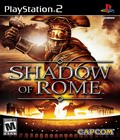Shadow of Rome
Publisher: Capcom
Developer: Capcom
Release Date: February 8, 2005
Buy 'SHADOW OF ROME': PlayStation 2
Shadow of Rome kind of snuck into existence. It was present at E3, but seriously overshadowed by Capcom’s recent offerings like Resident Evil 4, and came out to a near-total lack of fanfare.
That’s kind of weird, honestly, because Shadow of Rome is surprisingly good. It’s not a different historical setting for Onimusha, which is what I half-expected. Instead, it’s a rare thing: a game that divides its time cleanly between two vastly different genres, and does so without bollixing them both up.
When Shadow of Rome opens, it’s 44 B.C. On the borders of the expanding Roman Empire, its legions fight a constant battle against invading barbarian tribes, while at home, the corrupt imperial Senate are successfully distracting the people with bloody gladiatorial combat. This is the time of Julius Caesar, the great general and hero.
Caesar’s career is cut short by his assassination on March 15th, throwing the Roman Empire into chaos. A Roman soldier named Vipsanius is framed for Caesar’s murder, but both Caesar’s nephew Octavianus (the future Augustus Caesar) and Vipsanius’s son Agrippa, a young general in the Roman legions, know that Vipsanius is innocent.
While Octavianus remains in Rome and tries to solve the mystery of Caesar’s murder, Agrippa gives up his station and becomes a gladiator. A tournament is being held to determine who will have the honor of executing Vipsanius. If Agrippa can win the tournament, he’ll have a chance to rescue his father and reveal Caesar’s true assassins.
Shadow of Rome is equally divided between Agrippa’s game, an extraordinarily bloody brawler set on various battlefields and arenas, and Octavianus’s, which is about half stealth and half straightforward adventure game. Both modes use the same engine, which is nothing short of amazing; it’s been my experience that when you try to get one engine to do two wildly dissonant things within the same title, the situation rapidly deteriorates. Such is not the case here, and I’d go so far as to say that the engine deserves to be reused. (For example, it’d make a helluva Resident Evil or Dino Crisis game.)
Of the two modes in Shadow of Rome, I’m probably more impressed with Octavianus’s game. When you’re running around on the streets of Rome, the gameplay’s sort of pleasantly retro, where you get around obstacles by talking to people or thinking outside the box. If Octavianus is infiltrating a location, you get around by sneaking past people while their backs are turned, stealing somebody’s clothes and bluffing your way through any close encounters, or improvising weapons or distractions out of whatever happens to be handy. There’s one sequence where you can take out an entire group of bandits with a couple of banana peels; it takes a while to set up, but it’s a lot of fun.
Agrippa’s levels are more frustrating. Octavianus’s game has a kind of slapsticky, Saturday-afternoon-TV quality to it; Agrippa, on the other hand, is cutting people in half for the amusement of screaming Roman crowds. This is the kind of action where you can hack off somebody’s arm with a greataxe, then pick that arm up and beat somebody with it.
The more elaborate the bloodshed in the arena, the more the crowd loves it. If you play to the crowd by varying your attacks or showing off, they’ll throw you new weapons, which you will need. Whether it’s because of inferior Roman weaponcrafting or the fact that Agrippa appears to be a caveman, weapons break a lot in this game. You’re constantly stealing a new sword to replace the one you just busted over some mook’s head.
It’s not a big deal. As a matter of fact, I kind of like it; it keeps combat from devolving into the usual “charge and hammer X” idiocies that characterize a lot of 3D brawlers. That said, tthe fragility of Roman steel occasionally descends to the level of farce. A high-velocity encounter with a midget’s face should not bust a greatsword, and that’s all there is to it.
(Oh yeah. There are kung-fu midgets in Agrippa’s game. I know this is a draw for some of you. No, you can’t play as them.)
Shadow of Rome’s actual flaws, as opposed to questionable gameplay quirks, are really more like nitpicks. The camera could stand to be pulled a bit further back during the most intense fight scenes, the graphics are muddy at times, and the NPCs’ AI is roughly comparable to that of radishes. You can get the same guy to fall for the same trick fifteen times in a row if you really feel like it, and any gladiatorial combat where you’re forced to cooperate with an NPC ally is far more frustrating than it has to be. There’s one arena battle where you have to rescue a guy, and it’s like Capcom deliberately set out to make a new poster child for annoying escort missions everywhere. He’s suicidal; he’ll stand there like a dog that’s being shown a card trick while someone is hacking at him with a poleaxe.
I figure in about five years, Shadow of Rome will start showing up in magazine articles about “cult” games, or the best-kept secrets on the PS2. It’s been overshadowed by other recent high-profile releases, but Shadow of Rome is a great action game and an entertaining stealth game. I recommend it to fans of either.
Score: 8.9/10
More articles about Shadow Of Rome


















































